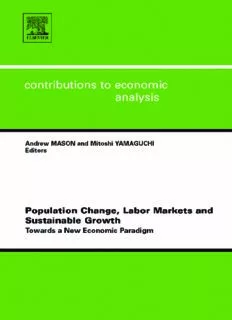
Population Change, Labor Markets, and Sustainable Growth: Towards a New Economic Paradigm PDF
Preview Population Change, Labor Markets, and Sustainable Growth: Towards a New Economic Paradigm
POPULATION CHANGE, LABOR MARKETS, AND SUSTAINABLE GROWTH TOWARDS ANEW ECONOMIC PARADIGM CONTRIBUTIONS TO ECONOMIC ANALYSIS 281 HonoraryEditors: D.W.JORGENSON J.TINBERGEN† Editors: B.BALTAGI E.SADKA D.WILDASIN Amsterdam –Boston– Heidelberg– London– New York – Oxford Paris – SanDiego– San Francisco– Singapore – Sydney – Tokyo POPULATION CHANGE, LABOR MARKETS, AND SUSTAINABLE GROWTH TOWARDS A NEW ECONOMIC PARADIGM Edited by Andrew Mason University ofHawaii– Manoa and the East-West Center,USA MitoshiYamaguchi Kobe University, Japan 2007 Amsterdam –Boston– Heidelberg– London– New York – Oxford Paris – SanDiego– San Francisco– Singapore – Sydney – Tokyo Elsevier Radarweg29,POBox211,1000AEAmsterdam,TheNetherlands TheBoulevard,LangfordLane,Kidlington,OxfordOX51GB,UK Firstedition2007 Copyright(cid:2)2007ElsevierB.V. Allrightsreserved Nopartofthispublicationmaybereproduced,storedinaretrievalsystem ortransmittedinanyformorbyanymeanselectronic,mechanical,photocopying, recordingorotherwisewithoutthepriorwrittenpermissionofthepublisher PermissionsmaybesoughtdirectlyfromElsevier’sScience&TechnologyRights DepartmentinOxford,UK:phone(+44)(0)1865843830;fax(+44)(0)1865853333; email:permissions@elsevier.com.Alternativelyyoucansubmityourrequestonlineby visitingtheElsevierwebsiteathttp://elsevier.com/locate/permissions,andselecting ObtainingpermissiontouseElseviermaterial Notice Noresponsibilityisassumedbythepublisherforanyinjuryand/ordamagetopersons orpropertyasamatterofproductsliability,negligenceorotherwise,orfromanyuse oroperationofanymethods,products,instructionsorideascontainedinthematerial herein.Becauseofrapidadvancesinthemedicalsciences,inparticular,independent verificationofdiagnosesanddrugdosagesshouldbemade LibraryofCongressCataloging-in-PublicationData AcatalogrecordforthisbookisavailablefromtheLibraryofCongress BritishLibraryCataloguinginPublicationData AcataloguerecordforthisbookisavailablefromtheBritishLibrary ISBN-13: 978-0-444-53051-6 ISBN-10: 0-444-53051-7 ForinformationonallElsevierpublications visitourwebsiteatbooks.elsevier.com PrintedandboundinTheNetherlands 07 08 09 10 11 10 9 8 7 6 5 4 3 2 1 CONTENTS List ofContributors vii Chapter1 Introduction 1 AndrewMason and Mitoshi Yamaguchi Chapter2 Evolution ofRecentEconomic-Demographic Modeling: ASynthesis 5 AllenC. Kelley and Robert M. Schmidt Chapter3 A Century ofDemographic Change and Economic Growth: The Asian Experience in Regional and Temporal Perspective 39 AllenC. Kelley and Robert M. Schmidt Chapter4 Demographic Dividends:The Past, the Present, and the Future 75 AndrewMason Chapter5 Demographic Change and Regional Economic Growth: A Comparative Analysisof Japan and China 99 Tomoko Kinugasa,Wei Huang, and Mitoshi Yamaguchi Chapter6 Job Opportunities for Older Workers: When Are JobsFilled with External Hires? 133 Robert Hutchens Chapter7 Skills, Wages, and the Employment of Older Workers 161 Naoki Mitani Chapter8 Work-Life BalanceMeasures and Gender Division of Labor 189 Akira Kawaguchi Chapter9 Optimal Education PoliciesUnder an Equity–Efficiency Trade-Off 211 Takashi Oshio Chapter10 WhyAre Japanese Refusing toPaythe National Pension Tax?: ASimultaneous Equation Analysis 243 MitoshiYamaguchi and Noriko Aoki Author Index 265 Subject Index 269 v This page intentionally left blank LIST OFCONTRIBUTORS Andrew Mason is Professor of Economics, University of Hawaii at Manoa, and Senior Fellow, Population and Health Studies, East-West Center, Honolulu. Mitoshi Yamaguchi is Professor of Economics, Graduate School of Economics, Kobe University. Noriko Aoki is a graduate student, Graduate School of Economics, Kobe University. Robert Hutchens is Professor of Economics, Department of Labor Economics, School of Industrial and Labor Relations, Cornell University. Akira Kawaguchi is Professor of Economics, Faculty of Policy Studies, Doshisha University. Allen C. Kelley is Professor of Economics, Duke University. TomokoKinugasaisAssociateProfessorofEconomics,GraduateSchool of Economics, Kobe University. NaokiMitaniisProfessorofEconomics,GraduateSchoolofEconomics, Kobe University. TakashiOshioisProfessorofEconomics,GraduateSchoolofEconomics, Kobe University. Robert M. Schmidt is Professor of Economics, University of Richmond. Wei Huang is a Ph.D. candidate, Graduate School of Economics, Kobe University. vii This page intentionally left blank CHAPTER1 Introduction Andrew Mason and Mitoshi Yamaguchi Population growth is in decline and populations are becoming older throughout the world. Low fertility is the common factor behind both of thesetrends.InmanyAsianandEuropeancountries,womenareaveraging fewer than two births over their reproductive span and, often, closer to one. With fertility so low, population decline is inevitable. Ever smaller cohortsofbirthsareleadingtoeversmallercohortsofchildrenandyoung adults, and eventually to populations in which the old greatly outnumber theyoung.Reinforcingtheeffectsoflowfertilityarecontinuingimprove- ments in life expectancy. In the past, mortality gains were achieved by reducing death rates among infants and children. This is still true in the world’spoorestcountries,butelsewheredeathratesamongtheyounghave reachedverylowlevels.Furthergainsarebeingachievedbyreducingdeath rates among the old, reinforcing the effects of fertility on population age structure.Asaconsequence,themostrapidlygrowingdemographicgroups in many countries are those in their 70s, 80s, and older. The contributions to this volume are concerned primarily with the economic implications of and the policy responses to these demographic changes. The original papers were prepared as part of a Center of Excel- lence (COE) research initiative, funded by the government of Japan and carried out by the Graduate School of Economics Research Institute for Economics and Business Administration at Kobe University. Leading scholars from Japan and the United States were invited to prepare papers on this common theme and to present them at the 4th International Conference of the Japan Economic Policy Association, co-sponsored by theKobeUniversityCenterofExcellenceandheldattheAwajiYumebutai International Conference Center in Awaji, Hyogo, Japan, during 17–18 December, 2005. The papers were refereed and revised in accordance with the reviewers’ suggestions prior to being copyedited. The issues addressed here are of interest everywhere, but they are particularly salient in Japan. Japan has the highest life expectancy and POPULATIONCHANGE,LABORMARKETS,ANDSUSTAINABLEGROWTH (cid:2)2007ElsevierLtd. VOLUME281 ISSN0573-8555/DOI10.1016/S0573-8555(07)81001-7 Allrightsreserved. 1
Description: